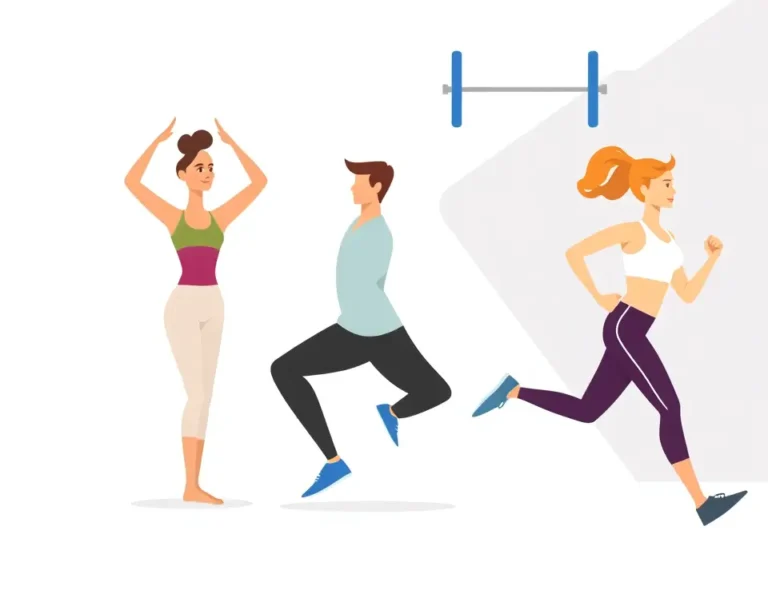Regular exercise is a cornerstone of good health, offering benefits from improved mood and weight management to reduced risk of chronic diseases. But with so many options available, designing an effective exercise routine can feel overwhelming. This guide breaks down the key components of a well-rounded fitness plan, offering insights and examples to help you create a routine that aligns with your goals and lifestyle.
Understanding the Essentials of an Exercise Routine
A comprehensive exercise routine should incorporate several key elements to ensure overall fitness and well-being. The National Institute on Aging recommends that adults engage in three primary types of exercise: aerobic, muscle-strengthening, and balance exercises.
Aerobic Exercise: Often called cardio, aerobic exercise involves activities that increase your heart rate and breathing, improving cardiovascular health. Examples include brisk walking, running, swimming, and cycling. The American Heart Association recommends at least 150 minutes of moderate-intensity aerobic activity or 75 minutes of vigorous-intensity activity per week, spread throughout the week.
Muscle-Strengthening Exercise: Strength training, or resistance training, involves working your muscles against resistance to build strength and endurance. This can include lifting weights, using resistance bands, or performing bodyweight exercises like push-ups and squats. Adults should aim to incorporate muscle-strengthening activities at least two days a week, working all major muscle groups.
Flexibility and Balance: Activities like stretching, yoga, and Pilates improve flexibility and balance, which are essential for maintaining mobility and preventing falls, especially as you age. These exercises can be incorporated into warm-ups, cool-downs, or as standalone sessions.
Designing Your Personalized Exercise Routine
Creating an exercise routine that fits your needs requires careful consideration of your fitness goals, current fitness level, and personal preferences. Here’s a step-by-step approach to help you get started:
1. Define Your Fitness Goals
Start by clearly defining what you hope to achieve through exercise. Are you aiming to lose weight, build muscle, improve cardiovascular health, or simply boost your overall well-being? Your goals will dictate the type and intensity of exercise you prioritize.
2. Assess Your Current Fitness Level
Be honest about your current fitness level. If you’re new to exercise, start with beginner-friendly activities and gradually increase the intensity and duration as you get fitter. If you’re already active, you can incorporate more challenging workouts.
3. Choose Activities You Enjoy
The key to sticking with an exercise routine is to choose activities you find enjoyable. Experiment with different types of exercise until you find something you look forward to doing. This could be anything from dancing and hiking to team sports and swimming.
4. Create a Weekly Schedule
Plan your workouts for the week, allocating specific days and times for each activity. A sample schedule might look like this:
- Monday: Cardio (30 minutes of brisk walking)
- Tuesday: Strength Training (full-body workout)
- Wednesday: Rest or Active Recovery (light stretching or yoga)
- Thursday: Cardio (30 minutes of cycling)
- Friday: Strength Training (focus on upper body)
- Saturday: Outdoor Activity (hiking or swimming)
- Sunday: Rest
5. Incorporate Variety
Variety is essential to prevent boredom and ensure balanced muscle development. Mix up your workouts by trying new activities, changing the order of exercises, or adjusting the intensity and duration. Activities that incorporate multiple types of exercise, such as yoga, dancing, or water aerobics can be very effective.
6. Warm-Up and Cool-Down
Always start your workouts with a 5-10 minute warm-up to prepare your muscles for activity. Dynamic stretches like arm circles and leg swings are ideal. End your workouts with a cool-down, including static stretches to improve flexibility and reduce muscle soreness.
7. Listen to Your Body
Pay attention to your body’s signals and don’t push yourself too hard, especially when starting a new routine. Rest and recovery are just as important as exercise, so allow your body time to recuperate between workouts.
Sample Exercise Routines
Here are a few sample exercise routines to illustrate how you can combine different types of exercise into a balanced plan:
Beginner Routine
This routine is designed for individuals who are new to exercise or returning after a break.
- Monday:
- Warm-up: 5 minutes of light cardio (e.g., walking) and dynamic stretching
- Cardio: 20 minutes of brisk walking
- Cool-down: 5 minutes of static stretching
- Tuesday:
- Warm-up: 5 minutes of light cardio and dynamic stretching
- Strength Training:
- Squats: 3 sets of 10-12 reps
- Push-ups (on knees if needed): 3 sets of as many reps as possible (AMRAP)
- Dumbbell rows: 3 sets of 10-12 reps per arm
- Plank: 3 sets, holding for 30 seconds
- Cool-down: 5 minutes of static stretching
- Wednesday: Rest
- Thursday: Repeat Monday’s routine
- Friday: Repeat Tuesday’s routine
- Weekend: Active recovery (e.g., light walk, yoga)
Intermediate Routine
This routine is suitable for individuals with some prior exercise experience.
- Monday:
- Warm-up: 5 minutes of cardio and dynamic stretching
- Cardio: 30 minutes of running or cycling
- Cool-down: 5 minutes of static stretching
- Tuesday:
- Warm-up: 5 minutes of cardio and dynamic stretching
- Strength Training:
- Barbell squats: 3 sets of 8-12 reps
- Bench press: 3 sets of 8-12 reps
- Pull-ups (assisted if needed): 3 sets of AMRAP
- Deadlifts: 1 set of 5 reps, 1 set of 3 reps, 1 set of 1 rep (increasing weight each set)
- Cool-down: 5 minutes of static stretching
- Wednesday: Active Recovery (yoga or swimming)
- Thursday:
- Warm-up: 5 minutes of cardio and dynamic stretching
- Cardio: 30 minutes of interval training (alternating between high and low intensity)
- Cool-down: 5 minutes of static stretching
- Friday:
- Warm-up: 5 minutes of cardio and dynamic stretching
- Strength Training:
- Lunges: 3 sets of 10-12 reps per leg
- Overhead press: 3 sets of 8-12 reps
- Rows: 3 sets of 8-12 reps
- Crunches: 3 sets of 15-20 reps
- Cool-down: 5 minutes of static stretching
- Weekend: Long hike or bike ride
Advanced Routine
This routine is designed for experienced individuals looking to challenge themselves and push their fitness to the next level.
- Monday: Upper Body Strength
- Warm-up
- Bench Press: 5 sets of 5 reps
- Overhead Press: 3 sets of 8 reps
- Pull-ups (weighted if possible): 3 sets to failure
- Dumbbell Rows: 3 sets of 10 reps per arm
- Accessory Work (e.g., bicep curls, tricep extensions)
- Cool-down
- Tuesday: Lower Body Strength
- Warm-up
- Barbell Squats: 5 sets of 5 reps
- Deadlifts: 1 set of 3 reps, 1 set of 1 rep (heavy)
- Lunges (weighted): 3 sets of 8 reps per leg
- Calf Raises: 3 sets of 15 reps
- Cool-down
- Wednesday: Active Recovery (swimming, mobility work)
- Thursday: Push/Pull Circuit
- Warm-up
- Circuit:
- Push-ups: 3 sets to failure
- Dumbbell Rows: 3 sets of 10 reps per arm
- Incline Dumbbell Press: 3 sets of 8 reps
- Pull-ups: 3 sets to failure
- Rest 1 minute between rounds; repeat 3-4 times
- Cool-down
- Friday: Full Body Conditioning
- Warm-up
- Kettlebell Swings: 3 sets of 15 reps
- Box Jumps: 3 sets of 8 reps
- Burpees: 3 sets of 10 reps
- Mountain Climbers: 3 sets of 20 reps
- Cool-down
- Weekend: Long, challenging hike or participate in a sports activity
Tips for Staying Motivated
Staying motivated is crucial for maintaining a consistent exercise routine. Here are some tips to help you stay on track:
- Set Realistic Goals: Break down your larger goals into smaller, more achievable milestones.
- Track Your Progress: Monitor your workouts and track your improvements to stay motivated and see how far you’ve come.
- Find a Workout Buddy: Exercising with a friend can provide support and accountability.
- Reward Yourself: Celebrate your achievements with non-food rewards, such as new workout gear or a relaxing massage.
- Don’t Give Up: Everyone has setbacks. If you miss a workout or two, don’t get discouraged. Just get back on track as soon as possible.
The Benefits of Regular Exercise
The benefits of regular exercise extend far beyond physical fitness. Exercise can:
- Improve Mood and Mental Health: Exercise releases endorphins, which have mood-boosting effects and can help reduce stress, anxiety, and depression.
- Help Manage Weight: Exercise burns calories and can help you achieve and maintain a healthy weight.
- Reduce the Risk of Chronic Diseases: Regular exercise can lower your risk of heart disease, stroke, type 2 diabetes, and some cancers.
- Improve Sleep Quality: Exercise can help you fall asleep faster and sleep more soundly.
- Increase Energy Levels: Regular physical activity can combat fatigue and boost your energy levels throughout the day.
- Promote Bone Health: Weight-bearing exercises can help increase bone density and reduce the risk of osteoporosis.
- Improve Cognitive Function: Exercise can improve memory, attention, and other cognitive functions.
By understanding the essentials of an exercise routine, designing a personalized plan, and staying motivated, you can reap the numerous physical and mental health benefits of regular physical activity.







